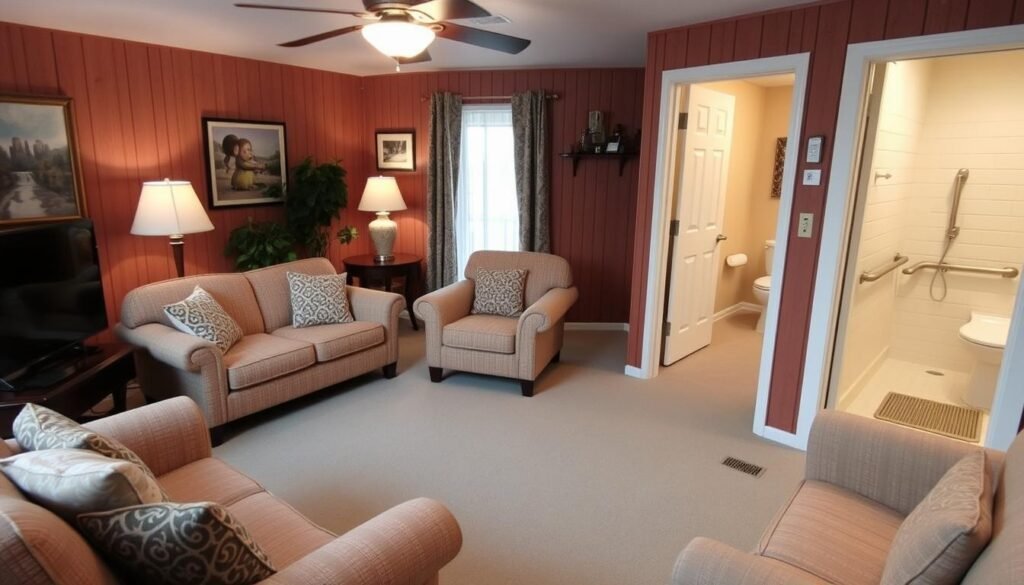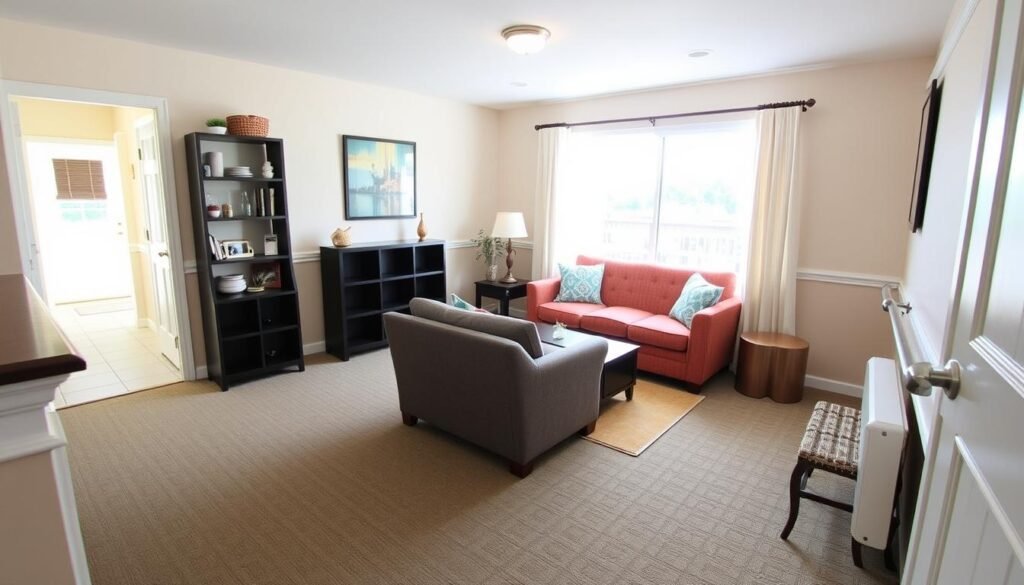As our parents get older, the thought of them leaving their home can be scary. But, what if we could help them stay in their beloved home? Is it possible to help aging parents stay in their home safely and comfortably? This guide looks at the emotional, financial, and practical ways to support your loved ones as they age in place.
Understanding the Importance of Aging in Place
Aging in place means living in one’s own home and community safely, independently, and comfortably, no matter the age or ability. Helping aging parents stay in their home has emotional and financial perks.
Emotional and Financial Benefits
Staying in a familiar place greatly benefits an older adult’s mental and emotional health. It avoids the stress of moving and keeps them independent, in control, and connected to their community. It’s also often cheaper than assisted living or nursing homes.
Challenges of Staying at Home
Helping aging parents stay at home has its challenges. Physical issues, safety worries, and the need for care can make it hard. It’s important to understand these challenges to support your parents well.
How to Help Aging Parents Stay in Their Home
Helping your aging parents stay in their home takes effort. But, with the right resources and plans, you can ensure their safety and well-being.
Home Modifications for Senior Safety and Accessibility
Home modifications are key to supporting aging in place. This includes making the bathroom and kitchen safer and adding assistive tech and devices.
Bathroom and Kitchen Adaptations
Bathrooms and kitchens can be tricky for older adults due to fall risks and accessibility issues. Adding grab bars, shower seats, and lever faucets can make these areas safer and easier for your parents.
Conclusion
Helping aging parents stay in their home is a caring and rewarding task. By understanding the benefits, tackling challenges, and using practical solutions, you can help your loved ones age in place with dignity. This guide is your first step in supporting your parents at home for as long as possible.
Key Takeaways
- Aging in place offers emotional and financial benefits for older adults.
- Home modifications, like adapting bathrooms and kitchens, improve senior safety and accessibility.
- In-home care and support services help aging parents stay independent.
- Assistive technologies support seniors in living independently.
- Creating a detailed plan is key to helping your aging parents stay in their home.
Understanding the Importance of Aging in Place
Aging in place means living in one’s own home and community safely, independently, and comfortably. This approach has many emotional and financial benefits for older adults. It helps seniors stay mentally well, keep their routines, and social connections. It can also save money compared to living in institutions.
Emotional and Financial Benefits
Living in familiar surroundings gives aging individuals a sense of security and comfort. Caring for elderly at home lets seniors keep their independence. They can still take part in community activities and avoid the stress of moving to a new place. Plus, it’s often cheaper than living in assisted facilities or nursing homes.
Challenges of Staying at Home
Even though many prefer aging in place, it comes with challenges. Older adults and their families face issues like mobility problems, needing home changes, and needing special help at home. To overcome these, things like home modifications for seniors and home health care options are key. They help make sure aging people can live safely and comfortably at home.
Knowing the benefits and challenges of aging in place helps families make good choices. They can plan and support their aging loved ones to stay in their homes as long as they can.
how to help aging parents stay in their home
Helping your aging parents stay in their home can be rewarding and challenging. By being proactive, you can help them live independently and comfortably. Let’s look at steps to support their wish to age in place.
Conduct a Comprehensive Home Assessment
Start by checking your parents’ home for safety and accessibility issues. Look for uneven floors, poor lighting, and missing handrails. Find areas that need changes, like the bathroom, kitchen, and entryways, to fit their needs.
Implement Necessary Home Modifications
After assessing the home, work with your parents to make home modifications for safety and mobility. This could mean installing grab bars, widening doorways, adding ramps, or changing the bathroom to a walk-in shower. These changes can greatly improve their life and let them stay in their familiar home.
Explore In-Home Care Options
As your parents need more help, think about in-home care services to support their daily life. This might be hiring a caregiver for a few hours a day or getting regular visits from a nurse or therapist. These caregiver support services are very helpful in keeping your parents independent.
Utilize Assistive Technologies
New assistive technologies can make your parents’ home safer and more accessible. Look into medical alert systems, remote monitoring devices, and voice-controlled smart home features. These technologies give your parents more security and freedom, letting them stay in their home with confidence.
Declutter and Downsize
Your parents may have a lot of possessions over the years. Encourage them to downsize and declutter their space, making it easier to move around. Getting rid of clutter makes their home safer and more comfortable for them.
By using these strategies, you can help your aging parents stay independent and happy in their own home. Remember, working together and respecting their wishes is key to a successful plan for aging in place.

| Home Modification | Benefits |
|---|---|
| Installing Grab Bars | Enhances stability and reduces the risk of falls in the bathroom |
| Widening Doorways | Improves mobility and accessibility for those using wheelchairs or walkers |
| Adding Ramps | Enables easier entry and exit from the home for those with limited mobility |
| Retrofitting the Bathroom | Provides a safer, more accessible bathing environment with features like walk-in showers |
Home Modifications for Senior Safety and Accessibility
As we age, it’s vital to keep living safely and independently at home. Making changes to our homes helps seniors stay in their familiar places. The bathroom and kitchen are key areas that need special attention due to the challenges they present for older adults.
Bathroom Adaptations
The bathroom is a central spot for daily routines. Making it safer can greatly improve senior safety. Adding grab bars near the toilet, shower, and tub helps with balance and stability.
Lowering the toilet and adding a walk-in shower or tub with a low step makes getting in and out easier. Non-slip flooring and good lighting also prevent falls and make it easier to move around.
Kitchen Modifications
The kitchen is crucial for daily living and may need changes for senior safety. Lowering countertops and adjusting cabinet heights makes reaching things easier and reduces the risk of injury. Task lighting and contrasting colors help seniors move around the kitchen better.
Hands-free faucets and automated appliances make the kitchen more user-friendly. These changes, along with assistive technologies, help seniors stay independent and comfortable at home.
By focusing on the unique needs of seniors, we can make bathrooms and kitchens safer and more accessible. These changes, along with assistive technologies, support older adults in aging in place. They help maintain independence and quality of life in their own homes.

| Bathroom Modifications | Kitchen Modifications |
|---|---|
|
|
“Home modifications are a key component of enabling older adults to age in place and maintain their independence and quality of life.”
Conclusion
Helping aging parents stay in their homes is key to elder care. It offers emotional and financial benefits. Families can plan and use strategies to keep their loved ones happy at home.
Adapting the home for safety and accessibility is important. There are many resources for in-home care and assistive tech. These help older adults stay independent and live well.
Deciding to age in place is personal. It’s vital to respect the wishes of older adults. Families can support them with the right resources. This way, aging parents can live fulfilling lives at home, with the people and things they love.
